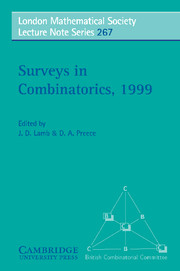Book contents
- Frontmatter
- Contents
- Preface
- The Rado Lecture
- The Invited Lectures
- Polynomials in Finite Geometries
- Applications of Combinatorial Designs to Communications, Cryptography, and Networking
- Random Walks on Combinatorial Objects
- Bose–Burton Type Theorems for Finite Projective, Affine and Polar Spaces
- Geometric Graph Theory
- Recent Excluded Minor Theorems for Graphs
- Parity, Cycle Space, and K4-Subdivisions in Graphs
Applications of Combinatorial Designs to Communications, Cryptography, and Networking
Published online by Cambridge University Press: 05 May 2013
- Frontmatter
- Contents
- Preface
- The Rado Lecture
- The Invited Lectures
- Polynomials in Finite Geometries
- Applications of Combinatorial Designs to Communications, Cryptography, and Networking
- Random Walks on Combinatorial Objects
- Bose–Burton Type Theorems for Finite Projective, Affine and Polar Spaces
- Geometric Graph Theory
- Recent Excluded Minor Theorems for Graphs
- Parity, Cycle Space, and K4-Subdivisions in Graphs
Summary
Summary Combinatorial designs have long had substantial application in the statistical design of experiments and in the theory of error-correcting codes. Applications in experimental and theoretical computer science have emerged, along with connections with the theory of cryptographic communication. This paper focuses on applications in the general area of communications, including cryptography and networking. Applications have been chosen to represent those in which design theory plays a useful, and sometimes central, role. Moreover, applications have been chosen to reflect in addition the genesis of new and interesting problems in design theory in order to treat the practical concerns. Of many candidates, thirteen applications areas have been included:
Optical orthogonal codes
Synchronous multiple access to channels
Group testing and superimposed codes
Erasure codes and information dispersal
Threshold and ramp schemes
Authentication codes
Resilient and correlation-immune functions
Multidrop networks
Channel graphs and interconnection networks
Partial match queries on files
Software testing
Disk layout and striping
(t, m, s)-nets and numerical integration
The theory of combinatorial designs continues to grow, in part as a consequence of the variety of these applications and the increasing depth of the connections with challenging problems on designs.
- Type
- Chapter
- Information
- Surveys in Combinatorics, 1999 , pp. 37 - 100Publisher: Cambridge University PressPrint publication year: 1999
- 37
- Cited by

